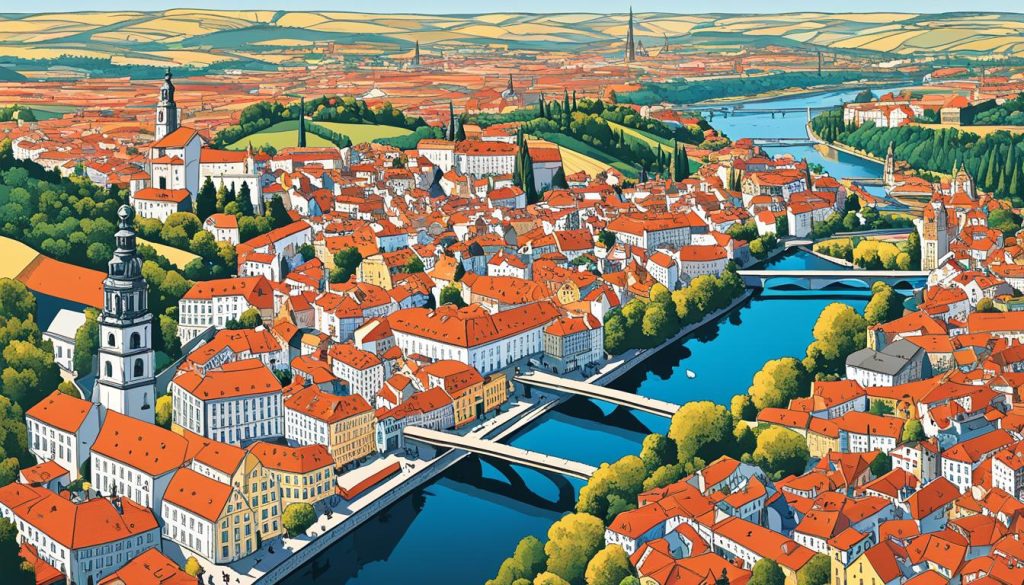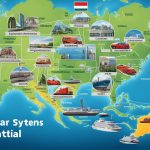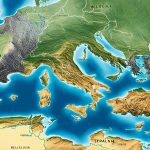Looking at Germany and Portugal shows us two very different worlds. Germany’s vast lands sit in the heart of Central Europe. They starkly contrast with Portugal’s warm, Iberian settings.
We’ll also see how their geography influences their infrastructure. From Germany’s wide autobahns to Lisbon’s ancient trams, the variety is striking. It’s a journey through the unique roads, railways, and cities molded by their landscapes.
Let’s dive deeper into how Germany and Portugal are set apart. We’ll explore the special ways their geography shapes their societies and economies.
Introducing the Nations: Germany and Portugal
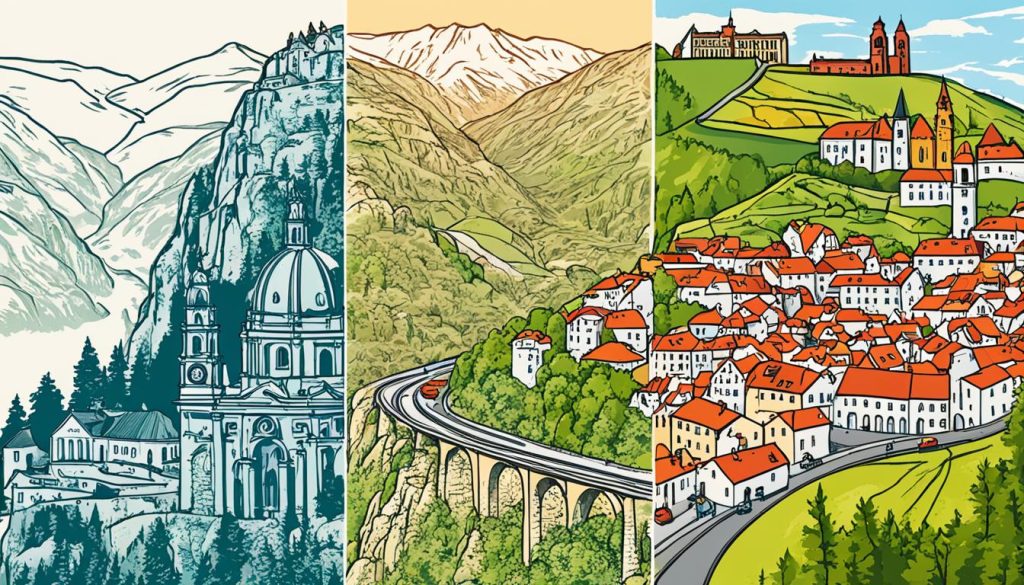
When we look at countries, we share key facts that help you understand what makes each one special. Germany and Portugal show big differences in their population numbers. Germany has a huge number of people, 83,798,000, making it a major player in Europe. Portugal, on the other hand, has 10,410,000 people.
This difference shows in how crowded places are. Germany has 234.3 people per square kilometre, while Portugal has 112.9. Yet, both countries have similar life spans. This tells us they have great healthcare and living conditions.
The money situation in Germany and Portugal also tells an interesting story. Both use the euro. But their economies are quite different. Germany only has a 3.0% unemployment rate, showing it’s financially strong. Portugal’s unemployment is higher, at 5.8%.
When it comes to what people earn, Germans make about $54,030 on average. In Portugal, the average income is much less, at $25,950. This highlights the economic gap within countries using the same currency.
- Population of Germany: 83,798,000
- Population of Portugal: 10,410,000
- Population density in Germany: 234.3 inhabitants/km²
- Population density in Portugal: 112.9 inhabitants/km²
- Unemployment rate in Germany: 3.0%
- Unemployment rate in Portugal: 5.8%
- Average income in Germany: $54,030
- Average income in Portugal: $25,950
A Tale of Two Regions: Western vs Southern Europe

Western and Southern Europe are distinct in their regional geography and cultural differences. Germany and Portugal show the diversity in European landscapes and histories. These elements shape their unique identities.
Differences in Location and Topography
Germany has a variety of landscapes that impact its regional geography. The North European Plain is fertile, and its uplands offer diverse climates. This variety supports different activities and shapes Germany’s social and economic life.
Portugal’s landscape is shaped by its long coastline. Its rugged interior and mountains create natural barriers. The Tagus River adds to the country’s complex landscape, affecting people’s lives.
Cultural Divergence
Germany and Portugal’s cultural differences match their geography. Germany’s terrain influences its culture, from literature to art. This shows how geography can shape a society.
- Germany’s culture, from Goethe to Beethoven, reflects its geography and climate.
- Portugal’s connection with the sea influences its art and music, showcasing its maritime history.
Portugal’s culture connects deeply with the sea. This shapes its identity, from Fado music to Azulejo tiles. Its unique culture stands out in Europe.
The link between regional geography, European topography, and cultural differences tells a story of two distinct European areas. It highlights the unique character of Germany and Portugal in Europe.
Land and Boundaries: A Comparative Overview

Looking into the territorial extent of Germany reveals its large size and diverse scenery. It shares borders with many European countries. These borders bring different landscapes and cultural exchanges. Germany’s strategic position in Europe is significant because of this.
In comparison, Portugal tells a unique story with its boundary comparisons. It has a smaller land size on the edge of the Iberian Peninsula. It shares a land border mainly with Spain. However, its vast maritime boundary highlights Portugal’s historic navigation prowess. This aspect underlines its rich seafaring history and extends far offshore.
Portugal’s territory also includes the Azores and Madeira archipelagos. These islands increase Portugal’s land and economic interests. They are key for tourism and maritime activities, adding value to Portugal’s strategic position.
- Germany’s land area: Encompasses a variety of environmental landscapes from lowlands to alpine regions.
- Portugal’s Iberian footprint: Characterised by a single, extensive land border with Spain and an expansive maritime boundary.
- Strategic archipelagos: The Azores and Madeira contribute significantly to Portugal’s territorial narrative.
The Urban Tapestry: Population Distribution and Demographics
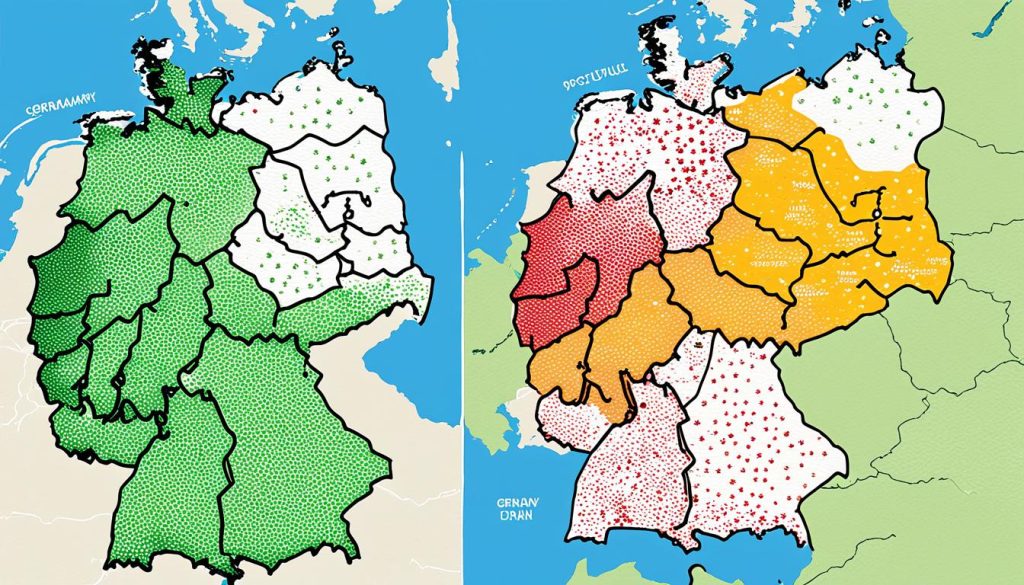
To understand Germany and Portugal’s demographics, we need to examine their population spread and urban trends. Germany’s cities are crowded and have an older average age. This shows growth centered around cities and demographic maturity. Cities like Berlin and Munich are key in culture, economy, and shaping demographics.
On the other hand, Portugal presents a different scenario. Its urban areas, mainly Lisbon and Porto, highlight its demographic patterns. Yet, it faces challenges like a shrinking population. Portugal’s average age is a bit younger than Germany’s but shows similar urban trends with major cities influencing demographics.
Looking at these trends, we find key points:
- Urban areas are dense due to better infrastructure and more jobs.
- Demographic trends affect public services and the kind of jobs available.
- Urban trends help shape policies on housing, transport, and city development.
Germany and Portugal are dealing with how demographics affect their society and economy. How these trends evolve will surely change their cities and regions.
The link between demographics and urban settings highlights their importance in a nation’s society. This analysis shows where Germany and Portugal are now and hints at future changes. These involve how people are spread out and how cities grow.
Contrasting Climates: Environmental Influences on Lifestyle

When we explore the climates of Germany and Portugal, we see how the environment deeply affects living conditions. People in these countries live in tune with their climates, shaping a connection with nature.
Temperate German Weather Versus Portugal’s Maritime Climate
Germany has a temperate climate, with cool winters and warm summers. This variety influences the country’s biodiversity and how people live. Germans adapt their outdoor activities, farming, and buildings to the changing climate.
In Portugal, the Atlantic Ocean shapes the climate. The north has cooler, wet weather which is good for growing grapes. Meanwhile, the south enjoys warmth with little rain, perfect for a Mediterranean lifestyle enjoyed by locals and visitors.
Seasonal Variation and Agricultural Impact
Seasonal changes greatly affect farming. Portugal’s long sunny days extend the growing season for many crops. This benefits farmers and boosts the economy, enhancing tourism.
- Longer summer days allow for increased productivity in vineyards and olive groves.
- Varied temperature ranges in Germany dictate the types of crops cultivated, often necessitating greenhouse cultivation in colder months.
- Seasonal festivities linked to agriculture, such as harvest festivals, underscore the derived lifestyle influences in each country.
To conclude, studying climates reveals their impact on daily life and farming. Germany and Portugal show how climate and culture combine to offer unique lifestyles.
Economies in Comparison: Fiscal Health and Employment
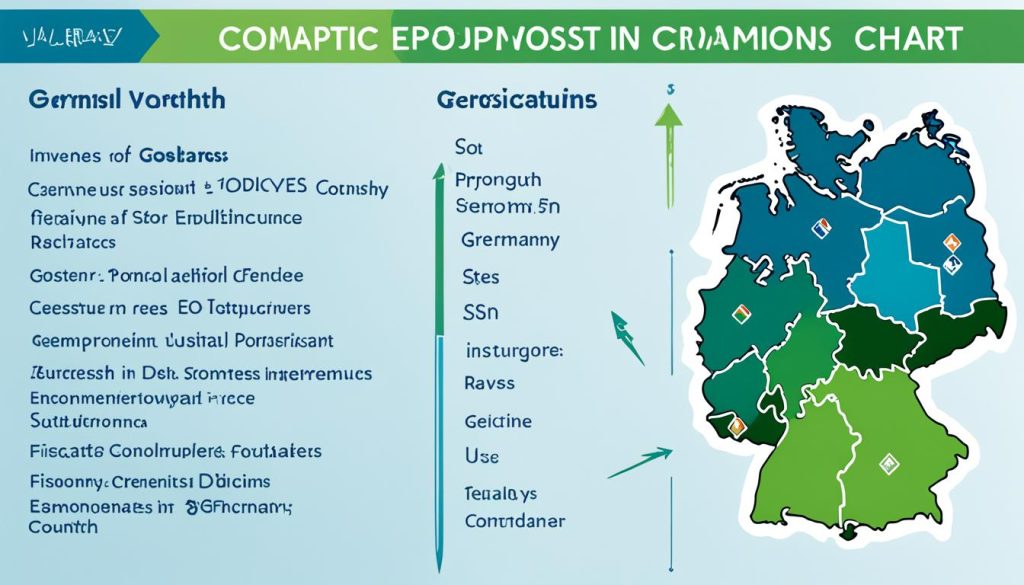
Comparing Germany’s and Portugal’s economic health reveals big differences. Germany shines with low unemployment and a balanced tax system. These are key for strong economic health.
Germany enjoys a low 3.0% unemployment rate. Portugal, however, struggles with a higher 5.8% rate. This difference affects both countries’ societies and economies in significant ways. Germany’s cost of living is 82.26%, similar to the USA, while Portugal’s is much lower at 67.93%.
- Taxation and contributions in Germany peak at 48.80%.
- Portugal’s tax rates are noticeably lower at 39.80%.
Fiscal comparisons influence citizens’ quality of life and local economies. Each country needs unique strategies to boost economic health and jobs.
The Backbone of Economy: A Look into GDP and National Income
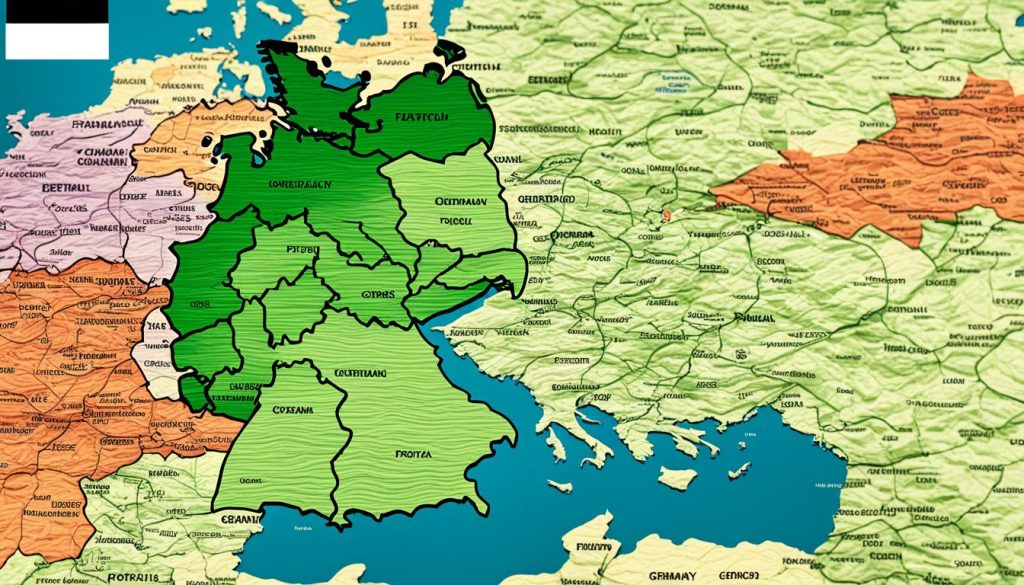
Looking at GDP and national income gives us insight into a country’s economic strength and living standards. When comparing Germany and Portugal, there’s a big difference in their economic power and the well-being of their citizens.
Comparative Analysis of GDP Figures
Germany and Portugal’s GDP figures show a huge gap. Germany’s GDP is a whopping 4,082,469 million USD, much larger than Portugal’s 255,197 million USD. This gap highlights Germany’s economic strength, showing its big role in both European and global markets.
Diving into the Average Income and Living Standards
Germany’s average income is $49,121, which shows a big difference in living standards between the two countries. On the other side, Portugal’s average income is $21,961. This shows the difference in national income affects everything from buying power to quality of life.
These income figures play a big part in economic growth. They also affect society, including healthcare, education, and social services access.
Education and Literacy: Shaping the Future
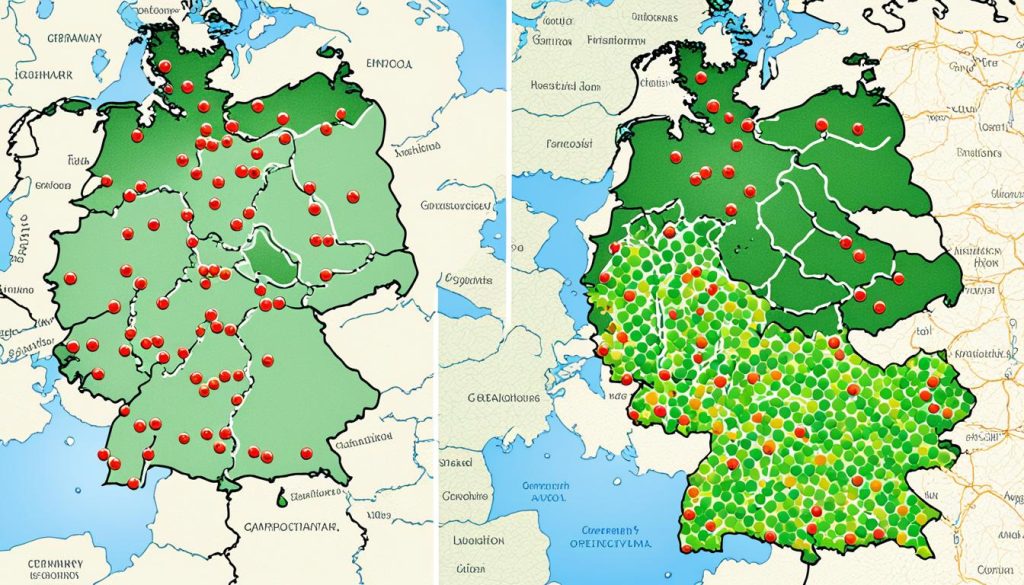
The future relies on the strength of education systems. Their success is often seen through literacy rates and scholastic investment. This discussion shows us how Germany and Portugal prepare young minds for the future. They both put a good part of their GDP into education.
In Portugal, 5% of the GDP goes to education. This shows their commitment to schooling, providing 17 years of education for all children. The result is a high literacy rate of 95.9% among its people.
Germany, on the other hand, focuses on innovation, especially in tech and science. This approach matches the country’s economic power. It ensures a skilled workforce, keeping Germany competitive globally.
- The German education system has a dual training system. It blends theoretical learning with real-world experience. This helps to keep unemployment rates low.
- Portugal has seen a rise in literacy rates following educational reforms, especially in higher education. These changes support its goal to boost its human capital and move towards a knowledge-based economy.
Both Germany and Portugal value educating their youth deeply. They know today’s learners are tomorrow’s leaders. By investing in unique educational systems, they improve literacy and job readiness. This effort significantly impacts their societies and economies.
Compare Geography and Infrastructure Between Germany and Portugal
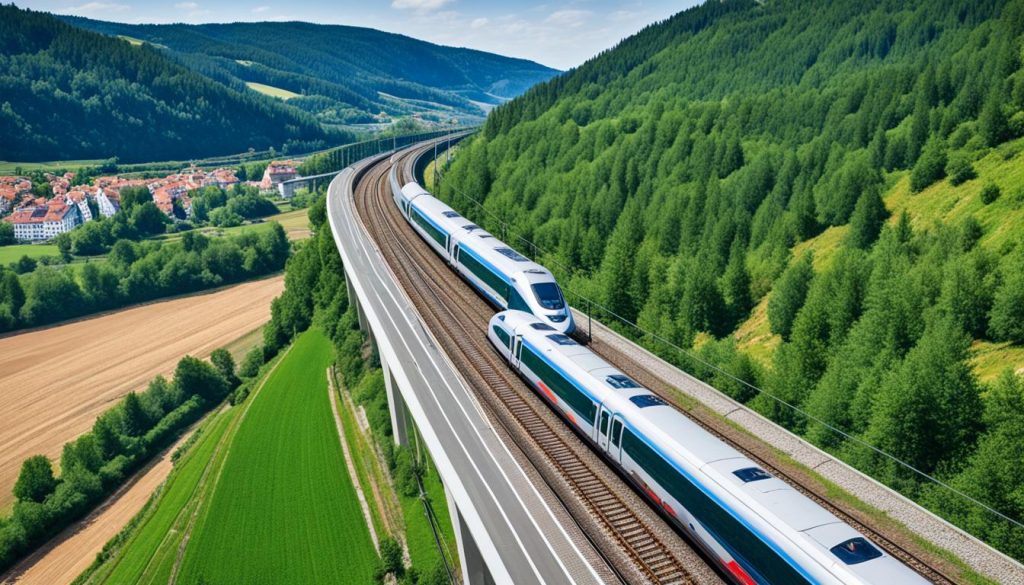
When examining the differences between Germany and Portugal, one must look at how they use their resources and manage their infrastructure. Germany and Portugal differ greatly in handling transport, energy policies, and telecommunication networks.
Assessing Land Utilization and Resources
Germany is known for its balanced industrial and agricultural zones. This shows their excellent resource management. On the other hand, Portugal is famous for its forests that support its cork industry and help protect the environment. These differences highlight the countries’ focuses on sustainability and economic goals.
Transportation Networks: Roads, Railways and Air Travel
Germany has a wide-reaching and efficient transport system. This includes its autobahns and railways that make travel and trade easy. Portugal has a smaller, but still effective, network. It serves its people well and keeps its ports open for trading.
Energy Production and Consumption Patterns
Germany stands out with its high energy production and use. This reflects its industrial power and high standard of living. Portugal uses less energy, focusing on renewable sources. It aims for a sustainable balance between energy use and conservation.
Telecommunication Systems: Connecting People
Both countries have strong telecommunication networks, with lots of mobile phone users. Germany’s large landline and internet usage shows its effort to connect many people. Portugal, while having a smaller system, efficiently meets its population’s communication needs for personal and business use.
Public Health: Healthcare Systems and Health Outcomes
Germany is known for its excellent healthcare services. They have a high number of hospital beds for every thousand people. This shows they can take good care of their patients. Portugal might have fewer doctors, but it still ensures everyone gets the healthcare they need.
Germany’s public health system works effectively, reducing diseases like HIV and tuberculosis. This success comes from strong public health policies and research. In contrast, Portugal has a higher rate of diabetes. This shows it faces different public health challenges and needs strategies to fight such diseases.
Germany and Portugal are both working hard to improve health for everyone. They do this by spending money on better medical technology and facilities. This not only shows they value healthcare highly but also makes sure they are ready to meet their people’s health needs.
- Germany’s significant investment in healthcare infrastructure ensures a wide array of services and technological advancements.
- Portugal, while managing a smaller scale healthcare system, focuses on preventative measures and managing chronic diseases like diabetes.
- Comprehensive public health initiatives in both countries aim to enhance overall health outcomes and ensure timely access to essential healthcare services.
Looking at public health data and comparing healthcare in these countries show how different their methods are. These variations in healthcare and the outcomes they achieve highlight what each country sees as important. It also aligns with the global goal of providing fair healthcare to everyone.
Trade and Industry: Exports and Imports
Exploring the trade analysis of Germany and Portugal reveals key insights. It sheds light on their export and import figures, showing their industrial performance. Germany stands out as a leading exporter. Its trade numbers are much higher than Portugal’s. This highlights Germany’s strong position in global trade and shows its diverse industries.
In contrast, Portugal has exports worth 126,541 million USD. It’s known for textiles and cork products. Yet, it’s smaller than Germany in industrial output. The import figures also show Germany’s high consumption, totalling 1,973,120 million USD. Portugal’s imports are at 131,627 million USD. These figures indicate the economic health of both countries and their market needs.
- Germany’s Import-Export Ratio: Reflecting a Balanced Trade Environment.
- Portugal’s Import Reliance: Indicating Room for Industrial Growth.
Trade numbers do more than show financial exchanges. They reflect the economic vitality and strategies of both countries. They help identify growth areas, product diversity, and changing trade trends.
- Germany’s Export Portfolio: Vehicles, Machinery, Pharmaceuticals.
- Portugal’s Export Niche: Olive Oil, Wine, Cork.
Looking closely at trade analysis and export and import figures unveils the overall industrial performance of Germany and Portugal. This analysis helps us understand not just trade numbers but also the economic impact and market power of these nations.
Navigating through Government Structure and Political Stability
Getting to grips with different government forms and political systems offers key insights into how countries function and stay strong. Take Germany, for example, its emphasis on structural precision and a solid federal government helps it stay steady with a high stability indexes score. Meanwhile, Portugal operates as a semi-presidential republic. It has a strong, though slightly less stable, political scene, contributing actively to Europe.
The success of these stable political scenes shows good governance in action. It’s where the mix of powers – legislative, executive, and judicial – join together to create an efficient state. Let’s look into how the stability of each country is measured and what it means:
- Germany boasts an stability index score of 81/100. This high score illustrates a mature political system with public trust in its democracy and governance.
- Portugal, though a tad lower at 74/100, still showcases a strong and stable political framework. Its system balances the powers between the President and the Prime Minister well.
Both countries exemplify lasting political stability and effective government forms. They offer systems that allow smooth transitions of power and policy-making that meets their people’s needs. This creates a great environment for investment, social progress, and engaging in international relations, especially within the EU framework.
Linguistic Diversity and Cultural Heritage
Exploring language diversity in Germany reveals a rich mix of cultures. Many dialects show Germany as a place where cultures blend. Immigrant communities bring languages like Turkish and Russian. This adds colour to Germany’s vibrant cultural heritages. The variety of languages enriches life and reflects Germany’s changing national identity. It shows Germany as a cultural leader in Europe.
- German – predominance in the linguistic landscape
- Turkish & Russian – significant representation within immigrant communities
- Other languages – reflections of wide-ranging cultural influences
In Portugal, things are a bit different. Portuguese unites the nation through speech. This unity highlights Portugal’s cultural oneness. It also strengthens a national identity built on maritime history and exploration. Portuguese serves not just to communicate. It tells of Portugal’s proud history and rich cultural heritages. These elements form Portugal’s identity through music like Fado and tales of exploration.
- Portuguese – the predominant language sculpting Portugal’s cultural heritages
- Cultural homogeneity – reinforcing a strong national identity
- Maritime exploration – a historic influence on language and culture
Both countries deeply value language diversity and cultural heritages. They form the core of their identities. Germany shows this through its mix of cultures. Portugal shows it through its unified language. Each country has a unique cultural voice. This voice is key to their national identity.
Diving into Quality of Life Indicators: Health, Civil Rights, and More
Looking at quality of life comparison means considering many areas. Germany and Portugal each have their strengths. Germany scores 94 in both health care rankings and civil liberties assessment.
Portugal gets 85 for health care, showing room for growth. Its score for civil liberties is 76. This shows its progress in granting freedom and rights to its people.
Portugal shines in offering a pleasant climate and low cost of living. These differences affect how people live and feel in Germany and Portugal.
- Germany’s Health Care Ranking: 94
- Germany’s Civil Liberties Assessment: 94
- Portugal’s Health Care Ranking: 85
- Portugal’s Civil Liberties Assessment: 76
- Portugal’s Climate Score: 72
- Portugal’s Cost of Living Score: 48
Discussing quality of life comparison gives a clear view for those thinking about living in Germany or Portugal. Looking at health care rankings and civil liberties assessment, along with lifestyle factors, helps understand what life might be like.
Conclusion
Our study compares two major European countries, highlighting their unique qualities. We see differences in geography, culture, and economy when we look at Germany and Portugal. Germany boasts a large area and strong economy, while Portugal enjoys a strategic sea location and mild weather. This analysis helps us grasp the special traits of each country within Europe.
Germany shines with its advanced infrastructure and technology, making life there vibrant. Portugal may be smaller, but it uses its position by the sea to stand out. This includes a focus on maritime activities and tourism. Both countries prioritize healthcare and education, enhancing their citizens’ lives.
Being part of the European Union, Germany and Portugal add their special touch to the mix. Germany brings economic power, whereas Portugal adds charm with its history and weather. This comparison shows how each country uses its strengths and faces its challenges. It makes us appreciate Europe’s diversity and how it progresses through cooperation among its different countries.

